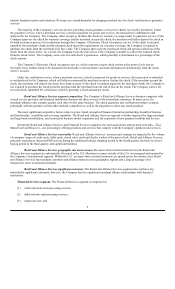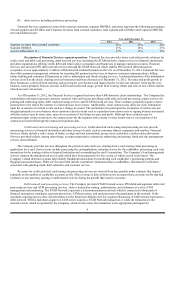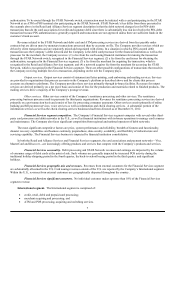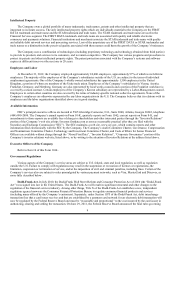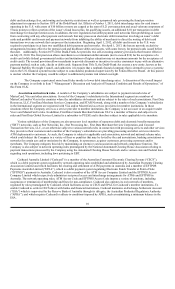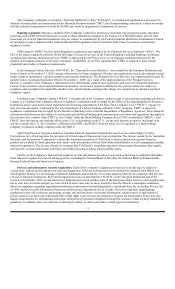First Data 2012 Annual Report Download - page 15
Download and view the complete annual report
Please find page 15 of the 2012 First Data annual report below. You can navigate through the pages in the report by either clicking on the pages listed below, or by using the keyword search tool below to find specific information within the annual report.
M
aterial breaches in security of the Compan
y
’s systems may have a significant effect on the Company’s business.
The uninterrupted operation of the Company’ s information systems and the confidentiality of the customer/consumer information
that resides on such systems are critical to the successful operations of the Company’ s business. The Company has security, backup and
recovery systems in place, as well as a business continuity plan to ensure the system will not be inoperable. The Company also has what
it deems sufficient security around the system to prevent unauthorized access to the system. However, the Company’ s visibility in the
global payments industry may attract hackers to conduct attacks on the Company’ s systems that could compromise the security of the
Company’ s data. An information breach in the system and loss of confidential information such as credit card numbers and related
information could have a longer and more significant impact on the business operations than a hardware failure. The loss of confidential
information could result in losing the customers’ confidence and thus the loss of their business, as well as imposition of fines and
damages.
Global economics, political and other conditions may adversely affect trends in consumer spending, which may adversely impact the
Company’s revenue and profitability.
The global electronic payments industry depends heavily upon the overall level of consumer, business and government spending.
A sustained deterioration in the general economic conditions, particularly in the United States or Europe, or increases in interest rates in
key countries in which the Company operates may adversely affect the Company’ s financial performance by reducing the number or
average purchase amount of transactions involving payment cards. A reduction in the amount of consumer spending could result in a
decrease of the Company’ s revenue and profits.
A weakening in the economy could also force some retailers to close resulting in exposure to potential credit losses and
transaction declines and the Company earning less on transactions due also to a potential shift to large discount merchants.
Additionally, credit card issuers may reduce credit limits and be more selective with regard to whom they issue credit cards. Changes in
economic conditions could adversely impact future revenues and profits of the Company and result in a downgrade of its debt ratings
which may lead to termination or modification of certain contracts and make it more difficult for the Company to obtain new business.
The Company’s debt agreements contain restrictions that will limit the Company’s flexibility in operating its business.
The indentures governing the Company’ s senior secured notes, senior second lien notes, senior notes, PIK toggle senior second
lien notes, and senior subordinated notes; the indenture governing senior PIK notes of First Data Holdings Inc.; and the Company’ s
senior secured credit facilities contain various covenants that limit the Company’ s ability to engage in specified types of transactions.
These covenants limit the Company’ s and its restricted subsidiaries’ ability to, among other things:
• incur additional indebtedness or issue certain preferred shares;
• pay dividends on, repurchase or make distributions in respect of the Company’ s capital stock or make other restricted
payments;
• make certain investments;
• sell certain assets;
• create liens;
• consolidate, merge, sell or otherwise dispose of all or substantially all of the Company’ s assets;
• enter into certain transactions with the Company’ s affiliates; and
• designate the Company’ s subsidiaries as unrestricted subsidiaries.
A breach of any of these covenants could result in a default under one or more of these agreements, including as a result of cross
default provisions and, in the case of the revolving credit facility, permit the lenders to cease making loans to the Company. Upon the
occurrence of an event of default under the Company’ s senior secured credit facilities, the lenders could elect to declare all amounts
outstanding under the Company’ s senior secured credit facilities to be immediately due and payable and terminate all commitments to
extend further credit. Such actions by those lenders could cause cross defaults under the Company’ s other indebtedness. If the Company
was unable to repay those amounts, the lenders under the Company’ s senior secured credit facilities could proceed against the collateral
granted to them to secure that indebtedness and the Company’ s secured and second lien notes. The Company has pledged a significant
portion of the Company’ s assets as collateral under the Company’ s senior secured credit facilities. If the lenders under the senior
secured credit facilities accelerate the repayment of borrowings, the Company may not have sufficient assets to repay the Company’ s
senior secured credit facilities and senior secured notes as well as the Company’ s second lien notes and unsecured indebtedness.
15


